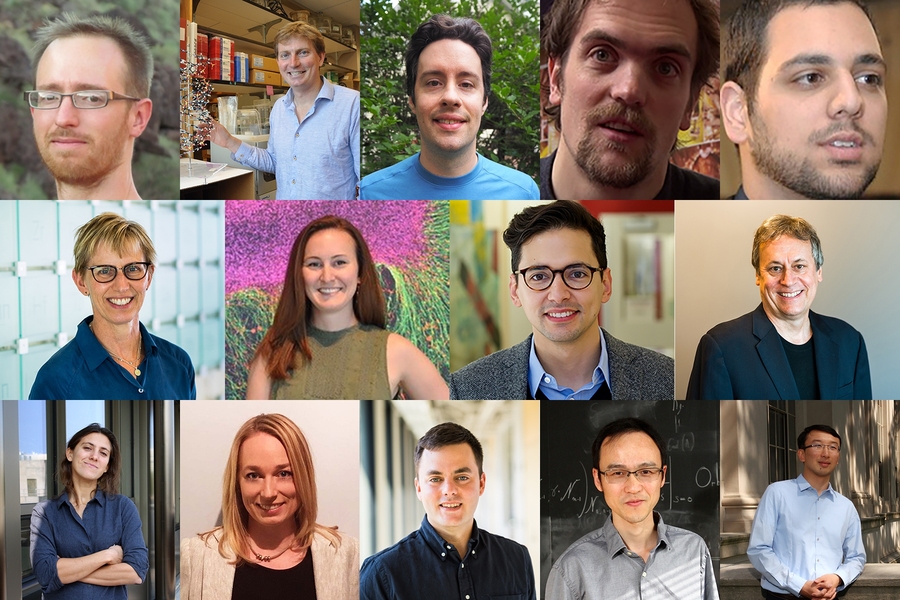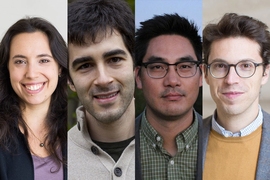This fall, the MIT School of Science has welcomed 14 new professors in the departments of Biology, Chemistry, Mathematics, and Physics.
Ian J. M. Crossfield focuses on the atmospheric characterization of exoplanets through all possible methods — transits, eclipses, phase curves, and direct imaging — from the ground and from space, with an additional interest in the discovery of new exoplanets, especially those whose atmospheres that can be studied in more detail. He joins the MIT Department of Physics as an assistant professor.
Joey Davis, an assistant professor in the Department of Biology, studies the molecular mechanisms underpinning autophagy using biochemical, biophysical, and structural biology techniques such as mass spectrometry and cryo-electron microscopy. This pathway is responsible for protein and organelle degradation and has been linked to a variety of aging associated disorders including neurodegeneration and cancer.
Daniel Harlow works on black holes and cosmology, viewed through the lens of quantum gravity and quantum field theory. He has joined the Department of Physics as assistant professor.
Philip Harris, a new assistant professor in the Department of Physics, searches for dark matter, seeking a deeper understanding of the petabytes of data collected at the Large Hadron Collider. Much of his research exploits new techniques to resolve the structure of quark and gluon decays, known as jet substructure.
Or Hen studies quantum chromodynamics effects in the nuclear medium, and the interplay between partonic and nucleonic degrees of freedom in nuclei, conducting experiments at the Thomas Jefferson and Fermi National Accelerator Laboratories, as well as other accelerators around the world. He has joined the faculty as an assistant professor in the Department of Physics and the Laboratory of Nuclear Science.
Laura Kiessling investigates how carbohydrates are assembled, recognized, and function in living cells, which is crucial to understanding key biological processes such as bacterial cell wall biogenesis, bacteria chemotaxis, enzyme catalysis and inhibition, immunity, and stem cell propagation and differentiation. She is the new Novartis Professor of Chemistry.
Rebecca Lamason investigates how intracellular bacterial pathogens hijack host cell processes to promote infection. In particular, she studies how Rickettsia parkeri and Listeria monocytogenes move through tissues via a process called cell-to-cell spread. She has joined the Department of Biology as an assistant professor.
Sebastian Lourido studies the molecular events that enable parasites in the phylum Apicomplexa to remain widespread and deadly infectious agents. Lourido uses Toxoplasma gondii to model processes conserved throughout the phylum, in order to expand our understanding of eukaryotic diversity and identify specific features that can be targeted to treat parasite infections. He has been welcomed into the Department of Biology as an assistant professor.
Ronald T. Raines, who has joined the faculty as the Firmenich Professor of Chemistry, uses techniques that range from synthetic chemistry to cell biology to illuminate in atomic detail both the chemical basis and the biological purpose for protein structure and protein function. He seeks insights into the relationship between amino-acid sequence and protein function (or dysfunction), as well as to the creation of novel proteins with desirable properties.
Giulia Saccà is an algebraic geometer with a focus on hyperkähler and Calabi-Yau manifolds, K3 surfaces, moduli spaces of sheaves, families of abelian varieties and their degenerations, and symplectic resolutions. She is now an assistant professor in the Department of Mathematics.
Stefani Spranger studies the interactions between cancer and the immune system, with the goal of improving existing immunotherapies or developing novel therapeutic approaches. Spranger seeks to understand how CD8 T cells, otherwise known as killer T cells, are excluded from the tumor microenvironment, with a focus on lung and pancreatic cancers. She has joined the Department of Biology as an assistant professor.
Daniel Suess works at the intersection of inorganic and biological chemistry, studying redox reactions that underpin global biogeochemical cycles, metabolism, and energy conversion. He develops chemical strategies for attaining precise, molecular-level control over the structures of complex active sites. In doing so, his research yields detailed mechanistic insight and enables the preparation of catalysts with improved function. Suess is an assistant professor in the Department of Chemistry.
Wei Zhang is a number theorist who works in arithmetic geometry, with special interest in fundamental objects such as L-functions, which appear in the Riemann hypothesis and its generalizations, and are central to the Langlands program. Zhang has joined the Department of Mathematics as a full professor.
Yufei Zhao, who has joined the Department of Mathematics as an assistant professor, works in combinatorics and graph theory, and is especially interested in problems with extremal, probabilistic, and additive flavors.







